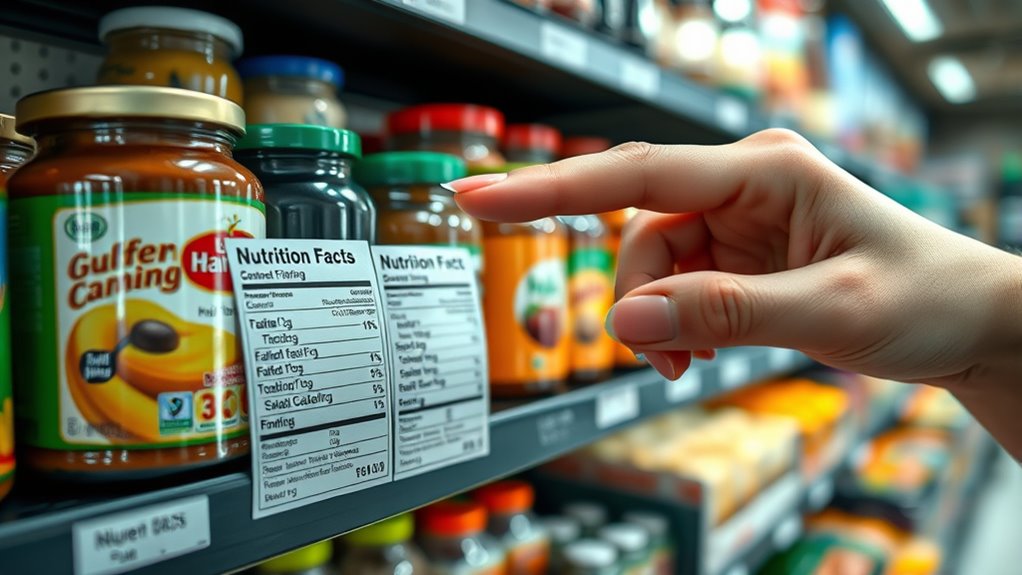You might think nutrition labels reveal the whole story, but they can be misleading if you don’t pay attention. Serving sizes often differ from what you actually eat, so it’s easy to underestimate your intake. Food marketing claims like “high in fiber” can hide added sugars or unhealthy ingredients. To make smarter choices, learn to interpret ingredient lists and compare portions. Keep going—there’s more to uncover that can help you make truly informed decisions.
Key Takeaways
- Always compare the serving size on the label to your actual portion to accurately assess calorie and nutrient intake.
- Read ingredient lists carefully; ingredients are listed from most to least, revealing hidden additives or unhealthy fats.
- Marketing claims like “high in fiber” can be misleading; verify with the ingredient list for true nutritional content.
- Be cautious of products with small serving sizes that can underestimate your actual nutrient consumption when you eat more than one.
- Understanding how to decode labels helps you make informed, healthier food choices and avoid being misled by packaging.

Have you ever looked at a nutrition label and wondered what all those numbers really mean? It can be confusing, especially when you’re trying to make healthier choices. The first thing to grasp is understanding serving sizes. Manufacturers often list nutrition info based on a specific portion, but that size isn’t always what you typically eat. For example, a snack bag might say it contains 200 calories per serving, but if you usually eat two servings at once, you’re actually consuming 400 calories. So, always check the serving size and compare it to how much you usually eat. If the serving size feels too small or doesn’t match your habits, do the math yourself to get a clearer picture of what you’re consuming. This way, you avoid underestimating your calorie and nutrient intake. Additionally, understanding serving size helps you better interpret the nutritional information in relation to your actual eating habits.
Always check serving sizes to accurately understand your calorie intake.
Reading ingredient lists is equally important. The ingredients are listed in order of quantity, from most to least. This list can reveal whether a product is truly healthy or packed with hidden additives. For example, a snack labeled “healthy” might be loaded with sugar or artificial flavors if those ingredients appear near the top of the list. Focus on whole, recognizable ingredients like nuts, fruits, or grains, and watch out for added sugars, preservatives, or unhealthy fats that might be lurking in processed foods. Being vigilant with reading ingredient lists helps you understand what’s actually in your food, beyond the marketing buzz on the front of the package.
Many people overlook these details, but doing so can lead to being misled by clever packaging or misleading marketing claims. Food companies often highlight certain nutrients like “high in fiber” or “low fat,” but those claims can obscure the fact that the product contains a lot of sugar or unhealthy fats. That’s why it’s essential to take the time to decode the facts on the label. By understanding serving sizes, you grasp how the numbers relate to your typical portions, and by reading ingredient lists, you see through the marketing to what’s really inside.
In the end, decoding nutrition labels isn’t about obsessing over every detail but about making informed choices. It’s about knowing what you’re eating and ensuring that your diet aligns with your health goals. When you pay attention to serving sizes and read ingredient lists carefully, you gain control over your food choices instead of falling for misleading labels. It takes a little extra effort, but it’s worth it for better health and smarter eating habits.
Frequently Asked Questions
How Can I Tell if a Product Is Truly Healthy?
To tell if a product is truly healthy, look for ingredient transparency and avoid items with high added sugar. Check the nutrition label for clear, simple ingredients—ideally whole foods or minimal processing. Be wary of products with lots of artificial additives or hidden sugars. By paying attention to ingredient lists and understanding added sugar content, you can make smarter choices and pick genuinely nutritious options for your diet.
Do “Low-Fat” Labels Mean the Product Is Low in Calories?
Think of “low-fat” labels as a red herring; they might look appealing but don’t tell the full story. These labels often lead to calorie misconceptions, as products can still be high in sugar or other ingredients that boost calories. A low-fat item isn’t automatically low in calories, so check the nutrition label carefully. Focus on overall fat content and serving sizes to truly gauge if it’s a healthier choice.
Are Organic Labels on Nutrition Labels Reliable Indicators of Health?
When you see organic labels, you’re likely wondering about organic credibility and label transparency. While organic labels suggest fewer pesticides and additives, they don’t guarantee overall health benefits. You should look beyond the label, checking for certifications and understanding that transparency varies. Trustworthy organic labels help, but they aren’t foolproof indicators of health—so stay informed and read ingredient lists carefully.
How Often Do Manufacturers Update Nutrition Labels?
You might wonder about label update frequency, and it’s a good question. Manufacturers are supposed to update nutrition labels when significant changes occur, but compliance varies. Sometimes, labels stay the same for years, even if formulations change. Other times, updates happen more regularly, especially if regulations tighten. So, stay vigilant—knowing that manufacturer compliance with label update requirements isn’t always consistent keeps you informed and empowered in choosing healthier options.
Can I Trust Serving Sizes Listed on the Package?
You might wonder if you can trust the serving sizes on packages. While manufacturers aim for portion accuracy, some labels aren’t perfectly consistent, which can be confusing. Always check the serving size details carefully, especially if you’re tracking intake. Remember, label consistency varies, so it’s wise to measure portions yourself when possible. Trust the information but stay vigilant—labels are helpful tools, not absolute guarantees.
Conclusion
Now that you know how to decode nutrition labels, you can make smarter choices. Did you know nearly 60% of people overlook serving sizes? That means many are unknowingly consuming more calories and sugar than they realize. By paying attention to the details, you take control of your health. So, next time you shop, read those labels carefully—your body will thank you for it. Small changes today lead to healthier habits tomorrow.









